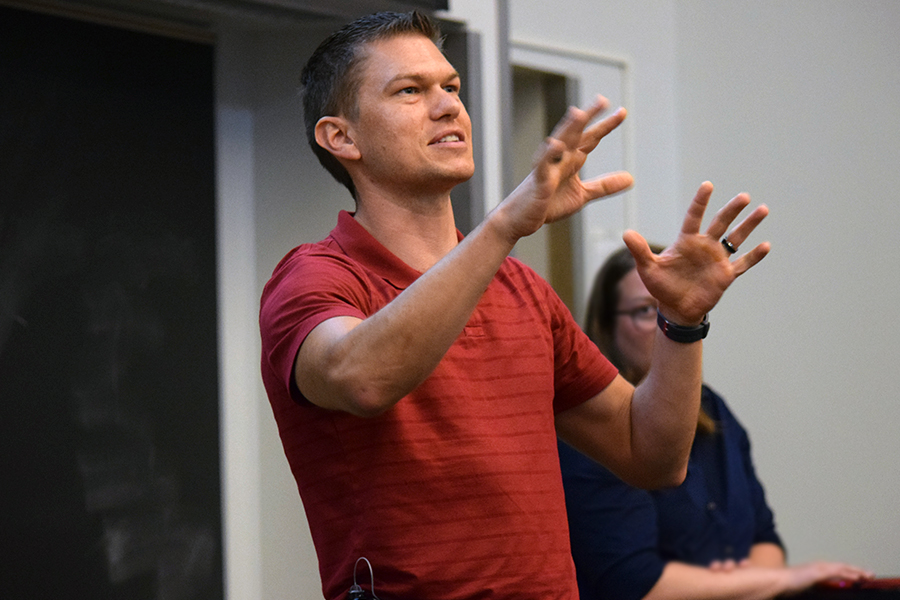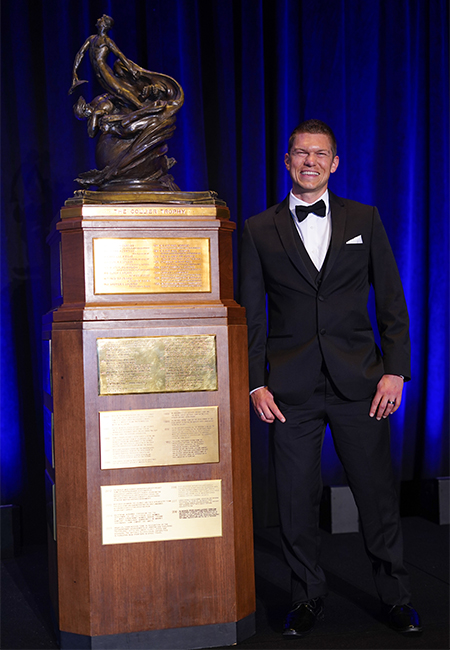AAE alum part of 'awesome' team awarded Collier Trophy

Collin Drake was in the back of an F-16, flying supersonic speed, headed toward the ground.
And he knew the pilot wasn’t going to pull up.
But even staring into the Mojave Desert traveling at more than 550 mph, Drake had a measure of composure.
Otherwise he wouldn’t have had much trust in the Air Force Research Laboratory’s Automatic Ground Collision Avoidance System (Auto GCAS), a project he’d been working on for four years at the time of that flight test in 2015.
Drake (MSAAE ’17) lived to tell the story of how Auto GCAS responded exactly the way it was supposed to — with the autonomous system initiating an automatic recovery just in time to avoid a crash — and he’s not the only one.
Through September 2019, nine lives have been saved by Auto GCAS, software that’s installed on more than 600 F-16 Block 40/50 aircraft. Eight aircraft have been spared by the system in the same span.
Over the next 20 years, the ARFL projects 172 pilots, 209 aircraft and $10.7 billion will be saved because of a system that’s been called a “game-changing advance in safety.”
In April 2019, the 412th Test Wing at Edwards Air Force Base in California — where Drake works as a flight science engineer — recommended Auto GCAS be fielded on the F-35 following a series of flight tests. That was a significant achievement, considering it was the result of a rapid process of design, integration and flight tests. Instead of taking as many as six years, the system was ready to be operated by users on that aircraft in less than one year, in part because the system’s maturity from the F-16 made the engineering integration timeline much shorter.
That remarkable progress resulted in the Auto GCAS team, including Drake, being awarded the National Aeronautics Association’s Robert J. Collier Trophy. The trophy is awarded annually for the “greatest achievement in aeronautics and astronautics in America, with respect to improving the performance, efficiency and safety of air or space vehicles, the value of which has been thoroughly demonstrated by actual use during the preceding year.”
On behalf of the 416th Flight Test Squadron at Edwards AFB, Drake attended the award presentation June 13 in Washington D.C., making sure to pose for photos with the 525-pound trophy that’s permanently on display at the Smithsonian National Air and Space Museum.
“It was incredible to know that you’re a part of such an awesome team to develop this sort of thing. It really makes me feel fortunate where my career has led, to be involved in projects like this,” Drake said. “It is incredible to see that people are recognizing the value of the system. What’s awesome about the Collier Trophy is going back to the demonstration in the actual world. It’s awesome to be involved in the engineering and development of it, but to know that it has been demonstrated in the real world and it has real world impact is absolutely amazing.
“This is actually the first time in the history of the Collier Trophy, since it’s been awarded in 1910, that software has been something that’s led the team to win the effort. Everything else has been hardware. Now, it’s actually the software capability that’s enabled the aircraft to save the pilot. They call this a pivotal step in aviation for that reason.”

On Sept. 10, Drake gave a deep dive into the technical elements of Auto GCAS during an informational talk to Purdue students as part of his return to campus for Industrial Roundtable. It was only the third time Drake had been to Purdue — his master’s in Aeronautics and Astronautics via the distance learning program.
This trip was as special as the others — the first for commencement in 2017 and a 2018 meeting about Purdue’s Federal Aviation Administration Center of Excellence PEGASAS — as Drake was able to share about his path to Purdue, the impact an AAE degree has had on his career, Edwards AFB and, of course, Auto GCAS.
Drake and Air Force colleagues Sarah Burmesch (BSAAE ’19) and Chris Valentino (MSE IDE ’16) also manned a booth on Memorial Mall to recruit students who are ready to “get their hands dirty” in a hands-on job at Edwards AFB, Drake said.
That’s what Drake lives daily as the lead flight sciences engineer who specializes in the flight control system of the F-16 with the 416th Flight Test Squadron, and, before that, as an avionics integration engineer.
“It’s a very fast-paced environment out there. There’s always something to do, multiple things to do at any one time,” Drake said. “We work in the control room. We plan the tests. We take a very methodical approach to it, then we actually execute the test. … We really think these problems through in flight test and how we would keep pilots safe. Then when we actually go to execute and we’re in the control room, we’re actually backing the pilots up, looking at data real-time, telling when to recover from the ground, if needed. After that, we’re analyzing the data and making sure the systems behave to the specifications.”
Often from 2015-2017 while Drake was taking online courses for his master’s, he’d find what he learned was directly — and immediately — applicable to his day-to-day responsibilities at Edwards. After working a 12-hour day during the week, Drake would go home and study. He’d load up the weekends with more coursework. Though a challenging experience, he said, ultimately, it was well worth the long hours.
“It did not take long before really digging into a lot of the things I was doing that, all of a sudden, I just find myself spitting out the information I had learned in grad school and I almost surprised myself that, wow, this really does have actual impact,” he said. “Especially through the aero department, I think it’s definitely kudos to Purdue for really being able to give that context in the coursework. There was always engineering context around what we were learning. We learned the theory, but the professors did a great job of giving case examples of their past experience — because a lot of them have worked in industry before or work with industry now.
“The quality of education is off the charts. I could not have asked for a higher-quality education, especially for a distance program. Because the quality of education was so high, I felt like it was just like being on campus as a student. I really liked that part about it. You have the same professors. You have the same TAs. You take the same tests. You do the same homework. You have the exact same lectures.”
